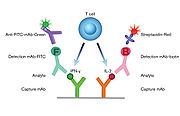
FluoroSpot
Encyclopedia
The FluoroSpot assay is a modification of the ELISPOT
assay. ELISPOT
usually measures the cellular secretion of one cytokine in each well by the use of an enzyme-labeled anti-cytokine antibody. FluoroSpot measures the secretion of several cytokines in each well by the use of fluorescent anti-cytokine antibodies. The method can be applied to essentially any system where one wants to investigate dual or triple protein secretion at the single cell level or where one wants to benefit from the fact that several cytokines can be assessed simultaneously in the same well, for example when there is a limited supply of cells. The FluoroSpot method is especially attractive in situations where the producing cells represent only a small fraction of the cell population, e.g. when studying polyfunctional T cells.
The sensitivity of the FluoroSpot assay is similar to that of the traditional ELISPOT
and it has been used to analyze both polyclonal and antigen-specific immune responses in ex vivo-stimulated peripheral T cells. Like the ELISPOT
, the FluoroSpot assay is simple to perform, sensitive and suitable for individual tests as well as for large-scale screening.
 The principle and procedure for FluoroSpot (see Fig 1) is similar to ELISPOT
The principle and procedure for FluoroSpot (see Fig 1) is similar to ELISPOT
. However, to detect cells secreting e.g. two different cytokines, a mixture of two capture antibodies, specific for the two cytokines, is coated in each well of a 96-well plate. Further on, after cellular stimulation, incubation and subsequent washing away of the cells, a mixture of two anti-cytokine antibodies is added to detect the secreted cytokines. To enable a separate detection of the two secreted cytokines, the two anti-cytokine antibodies are labelled with different tags, e.g. biotin and FITC. Following a wash to remove unbound antibody, the secreted cytokines are visualized by addition of a mixture of Streptavidin labelled with red fluorochrome and antibody to FITC labelled with green fluorochrome. The membrane of a well will thus contain a mixture of green and red spots. A cell, which has secreted both cytokines, will thus give rise to a green and a red spot at the same position on the membrane.
 To finally analyze the frequency of single and double-secreting cells, an automated FluoroSpot reader, equipped with separate filters for green and red fluorescence and software that detects single and co-localized green and red fluorescent spots, is preferred. Visually, spots representing dual secreting cells will appear as yellow in an overlay of green and red spot images (see Fig 2). By counting the number of spots in stimulated cultures and controls without stimulus the frequency of responding single and double secreting cells is determined.
To finally analyze the frequency of single and double-secreting cells, an automated FluoroSpot reader, equipped with separate filters for green and red fluorescence and software that detects single and co-localized green and red fluorescent spots, is preferred. Visually, spots representing dual secreting cells will appear as yellow in an overlay of green and red spot images (see Fig 2). By counting the number of spots in stimulated cultures and controls without stimulus the frequency of responding single and double secreting cells is determined.
ELISPOT
The Enzyme-linked immunosorbent spot assay is a common method for monitoring immune responses in humans and animals. It was developed by Cecil Czerkinsky in 1983....
assay. ELISPOT
ELISPOT
The Enzyme-linked immunosorbent spot assay is a common method for monitoring immune responses in humans and animals. It was developed by Cecil Czerkinsky in 1983....
usually measures the cellular secretion of one cytokine in each well by the use of an enzyme-labeled anti-cytokine antibody. FluoroSpot measures the secretion of several cytokines in each well by the use of fluorescent anti-cytokine antibodies. The method can be applied to essentially any system where one wants to investigate dual or triple protein secretion at the single cell level or where one wants to benefit from the fact that several cytokines can be assessed simultaneously in the same well, for example when there is a limited supply of cells. The FluoroSpot method is especially attractive in situations where the producing cells represent only a small fraction of the cell population, e.g. when studying polyfunctional T cells.
The sensitivity of the FluoroSpot assay is similar to that of the traditional ELISPOT
ELISPOT
The Enzyme-linked immunosorbent spot assay is a common method for monitoring immune responses in humans and animals. It was developed by Cecil Czerkinsky in 1983....
and it has been used to analyze both polyclonal and antigen-specific immune responses in ex vivo-stimulated peripheral T cells. Like the ELISPOT
ELISPOT
The Enzyme-linked immunosorbent spot assay is a common method for monitoring immune responses in humans and animals. It was developed by Cecil Czerkinsky in 1983....
, the FluoroSpot assay is simple to perform, sensitive and suitable for individual tests as well as for large-scale screening.
Principle and Procedure

ELISPOT
The Enzyme-linked immunosorbent spot assay is a common method for monitoring immune responses in humans and animals. It was developed by Cecil Czerkinsky in 1983....
. However, to detect cells secreting e.g. two different cytokines, a mixture of two capture antibodies, specific for the two cytokines, is coated in each well of a 96-well plate. Further on, after cellular stimulation, incubation and subsequent washing away of the cells, a mixture of two anti-cytokine antibodies is added to detect the secreted cytokines. To enable a separate detection of the two secreted cytokines, the two anti-cytokine antibodies are labelled with different tags, e.g. biotin and FITC. Following a wash to remove unbound antibody, the secreted cytokines are visualized by addition of a mixture of Streptavidin labelled with red fluorochrome and antibody to FITC labelled with green fluorochrome. The membrane of a well will thus contain a mixture of green and red spots. A cell, which has secreted both cytokines, will thus give rise to a green and a red spot at the same position on the membrane.


